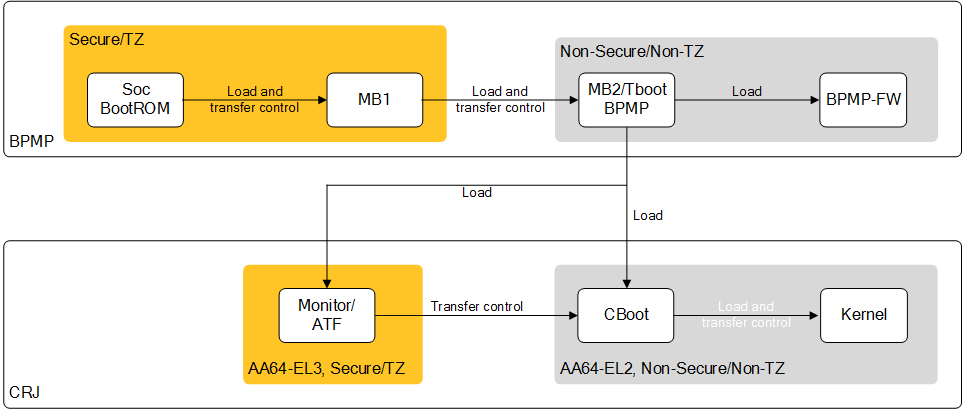Jetson AGX Xavier Boot Flow
The primary function of the Jetson AGX Xavier boot software is to initialize the SoC (System on Chip), including:
• Initializing MC/EMC/CPU
• Setting up security parameters
• Loading different firmware
• Maintaining Chain of Trust
• Setting memory carveouts for different firmware
• Flashing the device
• Booting to the operating system
Additionally, the Jetson AGX Xavier boot software also performs other operations defined by product requirements, including but not limited to:
• Initialization of HDMI™/DP
• Displaying the boot logo
The flow of control in the boot software is as follows.
BootROM
The Jetson AGX Xavier BootROM (BR) is hard-wired in the Tegra chip. It initializes the Boot Media and loads Microboot1 (MB1) from the Boot Media.
Multiple copies of the BootROM Boot Configuration Table (BR-BCT) may be stored at the start of the Boot-Media. The BR-BCT contains configuration parameters used by the BootROM for hardware initialization.
The BCT also contains information about the boot loader (BL), including:
• Size
• Entry point
• Load address
• Hash
The BootROM uses this information to verify and load the boot loader. The boot flow is as follows:
Boot Loader Components
The Jetson AGX Xavier boot loader and flash components are:
• Microboot1 (MB1)
• TBoot-BPMP
• CPU-BL
• TBoot-CPU (used in flashing)
• CBoot (used in cold boot)
Common Driver Framework
TBoot-BPMP, Tboot-CPU, and CBoot need to use a common set of drivers. Moreover, some libraries are common across the boot loader components. Instead of using separate sets of drivers and libraries, the binaries share a common pool of drivers and libraries called the Common Driver Framework (CDF).
The software architecture of the Common Driver Framework is as follows:
Common Driver Framework consists of:
• Storage drivers like eMMC, QSPI, mSATA, and UFS
• Host interface drivers like UART, USB
• Display drivers (HDMI, DP, and eDP)
• Debug and Console library
• Libraries of other modules such as:
• Clock
• SE
• PMIC
• Timer
• Fuse
• GPIO
• PWM
• EEPROM
• Keyboard
• PSCI
• USB host mode (2.0 mode only)
• USB host class drivers (only mass storage devices, no hub or HID support)
• Software libraries such as:
• Cryptographic
• Transport
• Partition manager
• Sparse
• Transport libraries
• A decompression library that supports LZF, Zlib, and LZ4
• clib, a dynamic memory allocation library, and a cache library
The CDF is provided at:
<top>/vendor/nvidia/tegra/bootloader/partner/common/
<top>/vendor/nvidia/tegra/bootloader/partner/t18x/common/
<top>/vendor/nvidia/tegra/bootloader/partner/t19x/common/Microboot1
Jetson AGX Xavier Microboot1 (MB1) is the first boot software component loaded by BR in SysRAM, and runs on BPMP. This component implements certain platform initialization (including CPU) and security configuration.
MB1 is signed and encrypted by an NVIDIA owned key. The following diagram shows the flow of control in MB1.
MB1 is responsible for:
• Platform configuration, including pinmux, GPIO , pad voltage, SCRs, and firewalls
• Initializing the SDRAM based on the MB1 boot configuration table (MB1-BCT)
• Loading firmwares, including the ones that initialize the CPU complex (CCplex)
• Programming the PMIC for enabling the VDD_CPU rail
• Creating memory carveouts
• Loading the next stage boot loader, TBoot-BPMP
MB1 is owned by NVIDIA, and so is provided as a binary in the BSP package. Although it is provided as a binary, you can configure its behavior for a specific platform using its Boot Configuration Table, called MB1-BCT.
For information on MB1, see MB1 BCT.
TegraBoot
Jetson AGX Xavier TegraBoot is the boot loader component that executes after MB1. This component is divided into two portions:
• TBoot-BPMP
• TBoot-CPU
The processor on which they are executing determines which component runs.
TegraBoot-BPMP
This portion of Jetson AGX Xavier TegraBoot runs on BPMP (TBoot-BPMP). There are two variants of TegraBoot-BPMP:
• One for cold boot
• One for flashing and RCM (recovery) boot
TBoot-BPMP is responsible for:
• Loading and initializing firmware (FW) components.
• Creating memory carveouts
• Unhalting the CPU
• Loading the next stage boot loader
• Supporting flashing
• Supporting RCM boot
The components of TBoot-BPMP are as follows:
TegraBoot-CPU
Jetson AGX Xavier TegraBoot-CPU is responsible for:
• Flashing
• RCM boot
The RCM boot flow is similar to a cold boot except that the binaries are transferred from the host over USB and loaded directly to SDRAM. TOS and BPMP-FW are not loaded in this path.
Note: | The CPU starts execution in EL3 mode, and executes the TOS monitor. The TOS monitor completes its initialization and gives control to the TegraBoot-CPU in EL2 mode. It then initializes the USB and starts the 3P protocol to flash the device. |
• For normal flashing, TegraBoot-CPU takes the binaries from the host one-by-one and flashes them to the device.
• In RCM boot, TegraBoot-CPU takes the binaries downloaded over USB. The binaries are not flashed onto the device.
The components of TBoot-CPU are as follows:
CBoot
Jetson AGX Xavier CBoot is the primary CPU boot loader used on mobile platforms in the cold boot path. CBoot is feature-rich boot loader based on Little Kernel (LK) that:
• Boots the kernel
• Supports display and boot logo
• Uses the interrupt and scheduling frameworks of LK
•
Note: | The CPU starts in EL3 mode and executes the TOS monitor. The TOS completes its initialization and passes control to CBoot in EL2 mode. |
BL and Kernel use separate device trees stored in separate partitions.
The components of CBoot are as follows:






